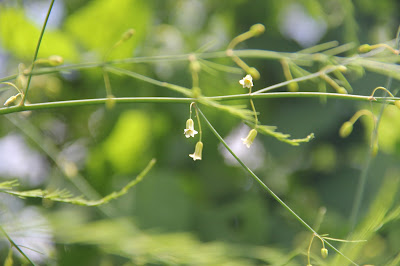Wildflowers of 2016 - #128 Garden Asparagus (Asparagus officinalis)
 |
| Garden Asparagus |
My first flower of the day was Garden Asparagus (Asparagus officinalis). This species is originally from Europe but is grown as a garden vegetable across North America. It commonly escapes from cultivation and can be found growing in the wild in every state but Alaska and Hawaii, and across the southern tier of Canadian provinces.
 |
| Bell-shaped Garden Asparagus flowers |
Garden Asparagus flowers are small (1/4 inch) and bell shaped. They dangle from the plant's branching stalk either singly or in pairs. The flowers may be greenish-white, yellow-green, or maroon colored. The plant's leaves are very small and scale-like. This species can grow as tall as 6 feet.
Wildflowers of 2016 - #129 American Bittersweet (Celastrus scandens)
I will admit that my next find had me stumped for a while. It didn't look quite like any species that I recognized. Eventually I decided that I needed help. So I sent my photos to a local plant expert. Eventually our combined efforts came to an identification of American Bittersweet (Celastrus scandens).
 |
| American Bittersweet |
American Bittersweet is typically a climbing vine that can reach lengths of 30 feet. On occasion, it will grow as a shrub - this is part of what caused my confusion. The plants that I found were not climbing, but instead seemed to be a cluster of shrubs.
 |
| American Bittersweet - note ovate leaves and green flowers |
The leaves on this species are ovate (egg-shaped) with serrated margins. They taper to a pointed tip. They grow alternately on the plant's branches/vines. American Bittersweet flowers are small (about 1/4 inch wide), and have five green petals with five green sepals and five yellow stamen.
 |
| American Bittersweet flowers - note five petals |
This species is found across the eastern United States a far west as Montana, Wyoming, and west Texas. A related species Oriental Bitterweet (C. orbiculatus) has been introduced from Asia and is considered an invasive species that is regulated by at least five states.
Thank you Cathy Murray for the identification help.
Wildflowers of 2016 - #130 Mossy Stonecrop (Sedum acre)
 |
| Mossy Stonecrop in a lawn |
Have you ever driven by a lawn and seen a large patch of yellow. There's a good chance that you have seen a patch of Mossy Stonecrop (Sedum acre). This native of Europe is commonly grown as garden plant. It tolerates dry soil soils very well and often escapes cultivation. It grows low to the ground (1 to 4 inches tall) and forms moss-like mats. The yellow flowers have measure about 3/8 inch across and look like five-pointed stars.
 |
| Golden stars - Mossy Stonecrop up close |
Upon leaving Pickens Field, I went to the south end of Island Park to photograph two more species that I had been waiting on.
Wildflowers of 2016 - #131 Western Poison Ivy (Toxicodendron rydbergii)
Michigan is home to two distinct species of Poison Ivy. Eastern Poison Ivy (Toxicodendron radicans) most commonly grows as a vine, using hairy rootlets to climb nearby objects. Less commonly, it will grow as a low shrub. Western Poison Ivy (Toxicodendron rydbergii) does not have hairy rootlets and grows only as a shrub. Another difference between the two species is that the leaves of Eastern Poison Ivy are usually flat while those of Western Poison Ivy are often folded at the mid-rib.
 |
| Western Poison Ivy thicket |
The flowers of both species are small (1/4 inch) and have five yellow-green or greenish-white petals. The flowers grow is loose clusters called panicles that may be 4 inches long by 4 inches wide. Upon pollination, the flowers develop into small waxy white berries that are eaten by many species of birds.
 |
| Western Poison Ivy - note how many of the leaves are folded at the mid-rib |
The plants that I photographed at the south end of Island Park were growing as bushes, lacked aerial rootlets, and had folded leaves - leading me to identify them as Western Poison Ivy (Toxicodendron rydbergii). To confuse matters more, the two species are suspected to hybridize.
 |
| Western Poison Ivy flowers up close |
I have written about Poison Ivy several times in the past - here is an index to those articles.
Wildflowers of 2016 - #132 Indian Hemp (Apocynum cannabinum)
My final species of the day was Indian Hemp (Apocynum cannabinum). Also known as Common Dogbane or Flowering Dogbane, Indian Hemp is one of two Apocynum species found in Michigan. The other species Spreading Dogbane (A. androsaemifolium) appeared on my Wildflowers of 2014 list, but Indian Hemp did not.
 |
| Indian Hemp - note opposite leaves, white flowers, and reddish stems |
Indian Hemp plants grow 1 to 5 feet tall. Plants may have a single stem, but often branch out. The stems are often red. Their leaves are arranged alternately along the stem, are oval or elliptic in shape (broader in the middle than at the ends), and measure 2 to 4 inches long. Indian Hemp flowers grow in a loose upright cluster called a panicle. Individual flowers measure 1/8 to 1/4 inch across, and have five pointed white petals.
 |
| Indian Hemp - a closer view of the flowers |
Indian Hemp is found across North America. It grows in a variety of upland and lowland habitats. In Michigan, it has been recorded in fifty-six of eighty-two counties.
No comments:
Post a Comment